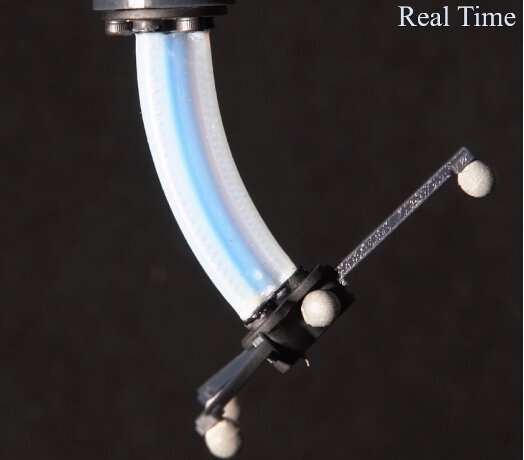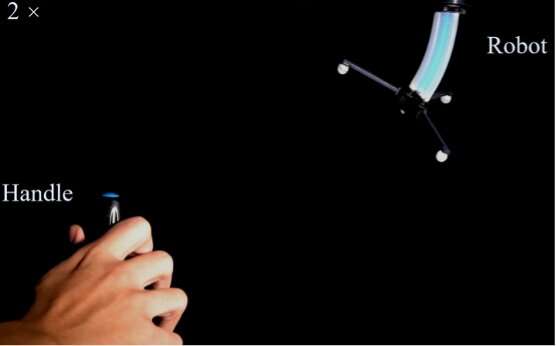A soft robotic tentacle controlled via active cooling

Robotic systems have become increasingly sophisticated over the past decades, improving both in terms of precision and capabilities. This is gradually facilitating the partial automation of some surgical and medical procedures.
Researchers at Tsinghua University have recently developed a soft robotic tentacle that could potentially be used to improve the efficiency of some standard medical procedures. This tentacle, introduced in IEEE Transactions on Robotics, is controlled through their novel control algorithm, together with the so-called active cooling for shape memory alloy, the actuating candidate for the robot.
“A neurosurgeon doctor one day came to our lab and asked about the possibility of developing a soft, controllable catheter for him to assist him in his neurosurgeries,” Huichan Zhao, one of the researchers who carried out the study, told Tech Xplore. “He would like this soft catheter to be extremely safe to the surroundings and be able to bend to different directions by a remote controller. Starting from these requirements, we developed a soft robotic tentacle.”
The initial prototype of the robotic tentacle created by Zhao and their colleagues had two key limitations. The first is that it moved too slowly and the second that its movements were difficult to control, particularly in the presence of known or unknown external disturbances.
To overcome these limitations, the researchers created an “multi-input-multi-output dual-channel” controller based on two control strategies for bending and swing motion, respectively, as well as the active cooling strategy for SMA materials, which would allow them to better control their robots’ movements. The main objective of this controller is to speed up the robotic tentacle’s actuation speed and improve its controllability, as this could in turn facilitate its real-world implementation.
“Our tentacle is actuated by heating/cooling three Shape Memory Alloy (SMA) springs,” Xin An, another researcher who carried out the study, told Tech Xplore. “These SMA springs would shrink/elongate upon heating/cooling respectively, therefore, driving the tentacle to bend in different directions with various angles. We used a few cameras and markers fixed on the robotic tentacle to find the real-time bending states of the tentacle, and a feedback controller to give commands to the SMAs and drive the tentacle to deform to a desired direction and bending angle.”
The SMA springs controlling the team’s robotic tentacle have a high energy density. As a result, the tentacle could also be adapted to be lightweight and compact, which might better suit some medical applications.

The researchers tested their system in a series of experiments, where they remotely controlled it to scan images of a room via an integrated camera. They found that it achieved very promising results, as it could perform different bending motions both effectively and rapidly.
“The robotic tentacle was successfully actuated by smart materials and formed a rather soft, dexterous, and controllable manipulator,” Zhao explained. “This means that in the future, we could potentially build a robotic arm, catheter or endoscope using soft materials with similar performances to those achieved by their rigid counterparts.”
While the researchers have so far only tested their robotic tentacle in their laboratory, they eventually also hope to test it in clinical settings, using it to perform real surgeries. To do this, they are now working to improve the actuation, sensing and control capabilities of their system further, to ensure that it could assist surgeons to perform internal inspections without harming a patient’s body.
“We now hope to integrate onboard sensors to get the real-time posture/shape of our robotic tentacle,” An added. “Inertial Measure Unit (IMU) and Fibber Bragg Gratings (FBG) are potential candidates for our sensing system. If we successfully get the posture/shape of our single tentacle module, we can connect multiple module segments into a longer soft manipulator with more dexterity.”
More information:
Xin An et al, Active-Cooling-in-the-Loop Controller Design and Implementation for an SMA-Driven Soft Robotic Tentacle, IEEE Transactions on Robotics (2023). DOI: 10.1109/TRO.2023.3234801
© 2023 Science X Network
Citation:
A soft robotic tentacle controlled via active cooling (2023, February 9)
retrieved 9 February 2023
from https://techxplore.com/news/2023-02-soft-robotic-tentacle-cooling.html
This document is subject to copyright. Apart from any fair dealing for the purpose of private study or research, no
part may be reproduced without the written permission. The content is provided for information purposes only.
For all the latest Technology News Click Here
For the latest news and updates, follow us on Google News.

